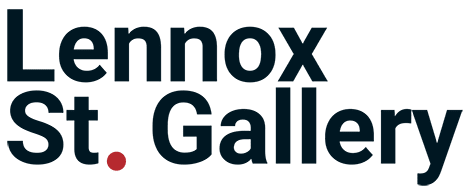Future Nostalgia: Louis Pratt
"Time present and time past
Are both perhaps present in time future,
And time future contained in time past." – TS Elliot
Future Nostalgia is an exhibition that seeks to hold the tension between the past and the future, realising it in the present.
As an artist, I am interested in the opportunities that new technologies promise. I use technology as part of a hybrid process, by working both by hand and with digital technologies. The technologies become just another tool, like a chisel or a paint brush. This hybrid process often requires me to go back and forth inside digital spaces and then to return to working by hand. I see this process as being reflective of the experience of our increasingly digitised/hybrid reality.
Some question the validity of using new technology in art, seeing it as a challenge to the supremacy of the hand of the artist. These developments in technology have always changed the way we make art through the ages; these changes then become a tradition. I believe issue lies in the speed of these changes today that have people questioning the use of technologies in art making. If technology was the issue, we would all still be doing cave paintings.
The quality of what makes compelling work is still the artist guiding the various tools of the day in order to express something of the experience of being human. It is an intuitive act for an artist to reflect back some quality of humanness in any media they choose. For this reason, we can understand it is the artists’ mind, rather than the artists’ hand, that ultimately drives all media and is paramount in the creative process.
I have always had a strong desire to challenge myself to make things that contribute to expanding what we understand as sculpture. This has led me to constant research and now formally undertaking PhD research at the University of Technology in Sydney, in Engineering and IT. While this highly technical field of study may seem like a counter-intuitive path for a practicing artist, I am interested in how I can apply developing technical possibilities to create art.
This process of using technology to create art, mirrors something we already experience, whether or not we are aware of it. We are constantly entering into and out of digital spaces to navigate our daily lives. The future will increase this hybrid experience, which is both embodied physically and also engaged in digital spaces.
In all these works, real-world space and digital spaces collide. The figurative works begin with living people who are digitised. This is then manipulated with digital tools before prototyping it back into the real-world. These prototyped sculptures then enter the archaic process of bronze casting, a process that has only incrementally changed over thousands of years.
Bronze is the oldest and most indelible art media we have; the oldest bronze is dated to 4500 BC. For this reason, bronze as a material is loaded with history. The patina I use references the bronzes of the past while the works engage with ideas of the near future.
In this show Future Nostalgia, I draw on past materials, techniques and reimagine them for the questions of the near future.
The glass etching works pay homage to another time in history – that of early photography. In the 1850s, photographers used glass plates negatives to produce their images. These glass negatives eventually succumbed to the march of progress, and were superseded by newer technology. As with the bronzes, I am reaching back to develop a visual language and exploring how can I render it to be relevant to today.
The etchings employ iconography that is part of our 21st century world, while drawing on a combination of traditional techniques and laser technology. Similar to the old glass plate negatives, the images are made in reverse. The etching is done by a laser, once lasered oil paint is worked in by hand. Once dry various types of metal leaf are applied using old sign writer’s techniques, of water and gelatine. Interestingly, gelatine was also involved in the production of those old glass plate negatives.
The ancient Greeks understood how to transform lifeless stone into lifelike sculptures. The way in which the figure is posed is critical. In Greece in 4th Century BCE, with the sculpture by Polykleitos's - Doryphoros (Spear-Bearer), Polykleitos developed a method of posing the body in a way that made it look alive and in motion. This technique has been named Contrapposto, or the counter pose. An example of this would be to have the weight balanced on one leg, with a twist in the waist and the head turned away.
One of the most famous examples of this is Michelangelo’s David. This posing technique is understood, consciously or unconsciously understood, and proliferates the imagery of people we see around us today for example on Instagram.
The word nostalgia comes from the Greek nostos (homecoming) and álgos (ache). It describes a longing to “return home” to a place or time. Perhaps we can also understand it as a yearning for the familiar – like hearing your mother tongue after a long time in a foreign country. Our tendency to always project and search for human reflections within objects/art is also a form of nostalgia, a yearning for that humanness in an ever-changing world.
This feeling is heightened in our ever increasingly digitised world and we experience nostalgia for the physical object. In a world where music, photographs and memories now exist as data, an object such as a printed photograph or an old record allows you to hold the past in your hand, to feel it as a tangible thing in the present.
Louis Pratt, 2021




